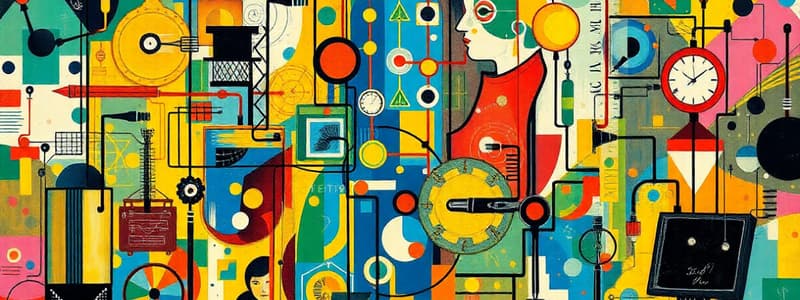Podcast
Questions and Answers
Who invented the telegraph?
Who invented the telegraph?
- Alexander Graham Bell
- John Logie Baird
- Samuel Morse (correct)
- Gugliemo Marconi
The telephone allowed real-time voice communication.
The telephone allowed real-time voice communication.
True (A)
What does ICT stand for?
What does ICT stand for?
Information and Communication Technology
The integration between information technology (IT) and ______ systems defines ICT.
The integration between information technology (IT) and ______ systems defines ICT.
Match the following inventor with their invention:
Match the following inventor with their invention:
Which communication advancement enabled global communication via space-based relays?
Which communication advancement enabled global communication via space-based relays?
The Analytical Engine, designed by Charles Babbage, was fully assembled and functional in the 1830s.
The Analytical Engine, designed by Charles Babbage, was fully assembled and functional in the 1830s.
Which technology enabled high-speed internet (up to 1Gbps), HD streaming, and VoIP in mobile communication?
Which technology enabled high-speed internet (up to 1Gbps), HD streaming, and VoIP in mobile communication?
The Von Neumann architecture proposes that both data and instructions are stored in the same ______.
The Von Neumann architecture proposes that both data and instructions are stored in the same ______.
Match the following developments with their corresponding generations of mobile technology:
Match the following developments with their corresponding generations of mobile technology:
Which of the following is NOT a characteristic of 1G mobile technology?
Which of the following is NOT a characteristic of 1G mobile technology?
Ada Lovelace is recognized for inventing the Pascaline.
Ada Lovelace is recognized for inventing the Pascaline.
What protocol suite standardized communication protocols and made the internet globally interoperable?
What protocol suite standardized communication protocols and made the internet globally interoperable?
Considered one of the fathers of artificial intelligence, ______ developed the concept of the Turing Machine.
Considered one of the fathers of artificial intelligence, ______ developed the concept of the Turing Machine.
What was the primary innovation introduced by the World Wide Web (WWW) in 1991?
What was the primary innovation introduced by the World Wide Web (WWW) in 1991?
Which of the following is NOT a benefit of a network infrastructure?
Which of the following is NOT a benefit of a network infrastructure?
A LAN (Local Area Network) is an example of a network extension.
A LAN (Local Area Network) is an example of a network extension.
The gap between those who can access new technologies and those who cannot is known as the ______.
The gap between those who can access new technologies and those who cannot is known as the ______.
Match the following network architectures with their descriptions:
Match the following network architectures with their descriptions:
Which protocol is commonly used for secure web communication?
Which protocol is commonly used for secure web communication?
Connection speed is the only parameter that is crucial for an efficient internet connection.
Connection speed is the only parameter that is crucial for an efficient internet connection.
What is the purpose of the Internet of Things (IoT)?
What is the purpose of the Internet of Things (IoT)?
In a spreadsheet, the intersections of rows and columns are called ______.
In a spreadsheet, the intersections of rows and columns are called ______.
Which of the following was the first spreadsheet program released?
Which of the following was the first spreadsheet program released?
Rows in a spreadsheet are indicated by letters.
Rows in a spreadsheet are indicated by letters.
What is the term for a collection of related data organized in a table?
What is the term for a collection of related data organized in a table?
In binary systems, the flow of binary digits is conventionally grouped into sequences of 8 bits, also known as a ______.
In binary systems, the flow of binary digits is conventionally grouped into sequences of 8 bits, also known as a ______.
With a sequence of n bits, how many different natural numbers can be represented?
With a sequence of n bits, how many different natural numbers can be represented?
The acronym ASCII stands for American Standard Code for ______ Interchange.
The acronym ASCII stands for American Standard Code for ______ Interchange.
Flashcards
ICT
ICT
Information and Communication Technology; technologies for storing, processing, and communicating information.
Telegraph
Telegraph
First long-distance wired communication system invented by Samuel Morse in 1837.
Telephone
Telephone
Invented by Alexander Graham Bell in 1876; enabled real-time voice communication.
Radio Transmission
Radio Transmission
Signup and view all the flashcards
Von Neumann Architecture
Von Neumann Architecture
Signup and view all the flashcards
Satellite Communications
Satellite Communications
Signup and view all the flashcards
ARPANET
ARPANET
Signup and view all the flashcards
TCP/IP Protocol
TCP/IP Protocol
Signup and view all the flashcards
World Wide Web
World Wide Web
Signup and view all the flashcards
1G Technology
1G Technology
Signup and view all the flashcards
3G Technology
3G Technology
Signup and view all the flashcards
ENIAC
ENIAC
Signup and view all the flashcards
Microprocessor
Microprocessor
Signup and view all the flashcards
AI & Quantum Computing
AI & Quantum Computing
Signup and view all the flashcards
Programming Language
Programming Language
Signup and view all the flashcards
Network Infrastructure
Network Infrastructure
Signup and view all the flashcards
TCP/IP
TCP/IP
Signup and view all the flashcards
Cloud Computing
Cloud Computing
Signup and view all the flashcards
Internet of Things (IoT)
Internet of Things (IoT)
Signup and view all the flashcards
Digital Divide
Digital Divide
Signup and view all the flashcards
Dataset
Dataset
Signup and view all the flashcards
Spreadsheet
Spreadsheet
Signup and view all the flashcards
Binary System
Binary System
Signup and view all the flashcards
Byte
Byte
Signup and view all the flashcards
ASCII
ASCII
Signup and view all the flashcards
Binary Encoding
Binary Encoding
Signup and view all the flashcards
Numeric Data
Numeric Data
Signup and view all the flashcards
Floating Point Representation
Floating Point Representation
Signup and view all the flashcards
Separation of Bits for Sign
Separation of Bits for Sign
Signup and view all the flashcards
Study Notes
ICT Definition & Evolution
- ICT: Information and Communication Technology, encompassing technologies for storing, processing, analyzing data, and communicating information digitally. It integrates information technology (IT) and telecommunication systems (TLC).
- Telegraph (1837): Invented by Samuel Morse. Introduced long-distance wired communication using Morse code. Widely adopted by businesses, governments, and armies.
- Telephone (1876): Invented by Alexander Graham Bell. Enabled real-time voice communication using wired electric signals. Adopted by businesses, governments, armies, and individuals.
- Radio Transmission (1896 & 1900s): Invented by Guglielmo Marconi. Created wireless communication systems. Developed from point-to-point to broadcasting (e.g., TV), further connecting the world.
- Satellite Communications (1960s): Enabled global communication via space-based relays.
- ARPANET (1969): Developed for research and defensive networks, forming the foundation of the modern internet.
- TCP/IP Protocol (1983): Standardized communication protocols enabling global internet interoperability.
- World Wide Web (1991): Introduced by Tim Berners-Lee. Revolutionized information access.
- 1G (1980s): Analog voice communication, basic voice calls, low quality, poor security.
- 2G (1991): Digital communication (GSM, CDMA), including SMS, voice encryption, and better call quality.
- 3G (2001): Mobile broadband (UMTS, HSPA). Offered internet access, video streaming, and speeds up to 2 Mbps.
- 4G (2009): LTE Technology, high-speed internet (up to 1 Gbps), HD streaming, and VoIP.
- 5G (2019): Ultra-fast speeds (up to 10 Gbps) and low latency (1 ms), real-time applications (AR/VR, autonomous vehicles).
- 6G (c.2030): Expected speeds of 1 Tbps, sub-millisecond latency, integration of AI and brain-computer interfaces.
Evolution of Information Technologies
- Blaise Pascal (1642): Invented the Pascaline, a mechanical calculator for addition and subtraction. Early example of mechanised computation.
- Charles Babbage (1830s): Designed the Analytical Engine, considered the first concept of a programmable mechanical computer, introducing principles of control and memory.
- Ada Lovelace (1840s): Worked with Babbage, writing the first algorithm for the Analytical Engine, recognized as the first computer programmer.
- Alan Turing (1930s-40s): Developed the Turing Machine, a theoretical model demonstrating computations via algorithms, considered a father of AI and modern computing.
- John von Neumann (1945): Proposed the Von Neumann Architecture, the basis of most modern computers, introducing the idea of stored-program computers (data and instructions in the same memory). Components rely on bistable devices (high/low voltage, positive/negative magnetic, on/off light). Data and instructions are coded in binary notation (0s and 1s).
- ENIAC (1945): First general-purpose electronic computer using vacuum tubes.
- UNIVAC (1951): First commercial computer designed for business and government use.
- Development of Programming Language (1950s-1960s): Creation of early languages (e.g., FORTRAN), increasing computer accessibility.
- Personal Computers and Microprocessors (1970s-1980s): Invention of the microprocessor (Intel 4004), rise of personal computers (Apple II, IBM PC).
- Internet and World Wide Web (1980s-1990s): Adoption of TCP/IP protocols, introduction of URLs, HTTP, HTML, and the World Wide Web revolutionizing information access/sharing.
- Mobile and Social Revolution (2000s-Present): Emergence of smartphones, mobile apps, and cloud sharing; social media redefined global interaction.
- IoT and Cloud Services (2010s-Present): Integration of computing into everyday devices (IoT), cloud-native applications and platforms became standard.
- AI, VR & Quantum Computing (2020s-Present): Rapid advancements in AI, machine learning, quantum computing, and immersive digital experiences (AR/VR).
ICT Tools
- Hardware: Computer architecture (motherboard, CPU, RAM, ROM), storage devices, input/output devices, connections, performance factors (processing power, memory, size, functionality).
- Software: Operating systems, application software, ease of use, ubiquitous use (mobile apps), access modalities (web apps, SaaS), programming language evolution.
- Networks: Network infrastructure benefits, taxonomy (wired/wireless, LAN/WAN/WLAN, client/server, peer-to-peer), internet, World Wide Web, TCP/IP, HTTPS, broadband (ultra-broadband, optical fiber, 5G), cloud computing, IoT.
Digital Coding
- Information: Formalizing data (numeric, alphanumeric) using symbols from a finite alphabet (composition rules for well-formed sequences).
- Alphabet and Sequences: Determine the number of possible sequences based on alphabet size and sequence length (n symbols, length k = nk different sequences).
- Binary Systems: Understanding bistable devices (e.g., voltage levels, magnetic polarization, light, binary digits used in computing). Data and instructions encoded in sequences of bits (measured in bytes).
- Binary encoding: Representing natural numbers (0 to 2n-1) using binary sequences (byte represents 0 to 255). Integer numbers (using the first bit for the sign). Floating-point numbers (using scientific notation). Text encoding (using sequences to represent symbols: ASCII, Unicode, UTF-8).
Spreadsheets
- Dataset: A collection of data organized in a matrix format (tables), with columns (variables) and rows (elements). Consolidation for processing from different sources.
- Spreadsheet: Evolution from 1961 (Mattessich concept) to VisiCalc (1978), Lotus 1-2-3 (1983), Microsoft Excel (1985), OpenOffice.org Calc (2000). Google Web Docs & Spreadsheets on any browser (2006).
- Spreadsheet components: Cells (row/column intersections), Rows (numbered), Columns (lettered), Worksheets (rows/columns), Workbooks (multiple worksheets).
Digital Divide
- Definition: The gap between those with access to new technologies and those without.
- Causes: Limited access to ICT infrastructure, computer illiteracy.
Studying That Suits You
Use AI to generate personalized quizzes and flashcards to suit your learning preferences.




